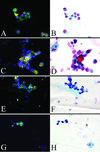Specific detection of prostate cancer cells in urine by multiplex immunofluorescence cytology
- PMID: 19368959
- PMCID: PMC2757169
- DOI: 10.1016/j.humpath.2009.01.004
Specific detection of prostate cancer cells in urine by multiplex immunofluorescence cytology
Abstract
Prostate cancer biomarkers are enriched in urine after prostatic manipulation, suggesting that whole cells might also be detectable for diagnosis. We tested multiplex staining of urinary sediments as a minimally invasive method to detect prostate cancer. Urine samples were collected from 35 men who had prostatic massage (attentive digital rectal examination) in a urology clinic and from 15 control men without urologic disease and without massage, for a total of 50 specimens (27 cancer-positive cases and 23 cancer-negative cases). LNCaP prostate cancer cells spiked into urine were used for initial marker optimization. Urine sediments were cytospun onto glass slides and stained. Multiplex urine cytology was compared with conventional urine cytology for cancer detection; anti-alpha-methylacyl-CoA racemase antibody was used as a marker of prostate cancer cells, anti-Nkx3.1 as a marker of prostate epithelial cells, anti-nucleolin as a marker of nucleoli, and 4'-6-diamidino-2-phenylindole to highlight nuclei. Prostate cancer cells were successfully visualized by combined staining for alpha-methylacyl-CoA racemase, Nkx3.1, and nucleolin. Of the 25 informative cases with biopsy-proven prostate cancer, 9 were diagnosed as suspicious or positive by multiplex immunofluorescence urine cytology, but only 4 were similarly judged by conventional cytology. All cases without cancer were read as negative by both methods. The multiplex cytology sensitivity for cancer detection in informative cases was 36% (9/25), and specificity was 100% (8/8). In conclusion, we have successfully achieved multiple staining for alpha-methylacyl-CoA racemase, Nkx3.1, nucleolin, and 4'-6-diamidino-2-phenylindole to detect prostate cancer cells in urine. Further refinements in marker selection and technique may increase sensitivity and applicability for prostate cancer diagnosis.
Conflict of interest statement
The authors have no disclosures to declare nor any competing interests that would constitute a conflict of interest regarding the work described in this manuscript.
Figures


Similar articles
-
A novel method for detection of exfoliated prostate cancer cells in urine by RNA in situ hybridization.Prostate Cancer Prostatic Dis. 2021 Mar;24(1):220-232. doi: 10.1038/s41391-020-00272-6. Epub 2020 Aug 20. Prostate Cancer Prostatic Dis. 2021. PMID: 32820256
-
Alpha-methylacyl-CoA racemase and hepsin as urinary prostate cancer markers.Int J Biol Markers. 2015 Nov 11;30(4):e401-6. doi: 10.5301/jbm.5000146. Int J Biol Markers. 2015. PMID: 25982684
-
A duplex quantitative polymerase chain reaction assay based on quantification of alpha-methylacyl-CoA racemase transcripts and prostate cancer antigen 3 in urine sediments improved diagnostic accuracy for prostate cancer.J Urol. 2009 Jun;181(6):2508-13; discussion 2513-4. doi: 10.1016/j.juro.2009.01.110. Epub 2009 Apr 16. J Urol. 2009. PMID: 19371911 Free PMC article.
-
Urinary biomarkers of prostate cancer.Int J Urol. 2018 Sep;25(9):770-779. doi: 10.1111/iju.13734. Epub 2018 Aug 21. Int J Urol. 2018. PMID: 30129068 Review.
-
Beyond prostate-specific antigen - future biomarkers for the early detection and management of prostate cancer.Clin Oncol (R Coll Radiol). 2012 Oct;24(8):545-55. doi: 10.1016/j.clon.2012.05.001. Epub 2012 Jun 7. Clin Oncol (R Coll Radiol). 2012. PMID: 22682955 Review.
Cited by
-
Colorimetric TMPRSS2-ERG Gene Fusion Detection in Prostate Cancer Urinary Samples via Recombinase Polymerase Amplification.Theranostics. 2016 Jun 15;6(9):1415-24. doi: 10.7150/thno.15250. eCollection 2016. Theranostics. 2016. PMID: 27375789 Free PMC article.
-
Cellular Refractive Index Comparison of Various Prostate Cancer and Noncancerous Cell Lines via Photonic-Crystal Biosensor.Proc SPIE Int Soc Opt Eng. 2019 Feb;10881:108810K. doi: 10.1117/12.2507505. Epub 2019 Mar 4. Proc SPIE Int Soc Opt Eng. 2019. PMID: 32313355 Free PMC article.
-
Overexpression of Nucleolin and Associated Genes in Prostate Cancer.Int J Mol Sci. 2022 Apr 19;23(9):4491. doi: 10.3390/ijms23094491. Int J Mol Sci. 2022. PMID: 35562881 Free PMC article.
-
Long Noncoding RNAs AC009014.3 and Newly Discovered XPLAID Differentiate Aggressive and Indolent Prostate Cancers.Transl Oncol. 2018 Jun;11(3):808-814. doi: 10.1016/j.tranon.2018.04.002. Epub 2018 May 1. Transl Oncol. 2018. PMID: 29723810 Free PMC article.
-
Metabolic alterations in urine extracellular vesicles are associated to prostate cancer pathogenesis and progression.J Extracell Vesicles. 2018 May 7;7(1):1470442. doi: 10.1080/20013078.2018.1470442. eCollection 2018. J Extracell Vesicles. 2018. PMID: 29760869 Free PMC article.
References
-
- Bologna M, Vicentini C, Festuccia C, et al. Early diagnosis of prostatic carcinoma based on in vitro culture of viable tumor cells harvested by prostatic massage. Eur Urol. 1988;14:474–476. - PubMed
-
- Garret M, Jassie M. Cytologic examination of post prostatic massage specimens as an aid in diagnosis of carcinoma of the prostate. Acta Cytol. 1976;20:126–131. - PubMed
-
- Albers DD, Mc DJ, Thompson GJ. Carcinoma cells in prostatic secretions. J Am Med Assoc. 1949;139:299–303. - PubMed
-
- Guinan P, Gilham N, Nagubadi SR, Bush I, Rhee H, McKiel C. What is the best test to detect prostate cancer? CA Cancer J Clin. 1981;31:141–145. - PubMed
-
- Sharifi R, Shaw M, Ray V, Rhee H, Nagubadi S, Guinan P. Evaluation of cytologic techniques for diagnosis of prostate cancer. Urology. 1983;21:417–420. - PubMed
Publication types
MeSH terms
Substances
Grants and funding
LinkOut - more resources
Full Text Sources
Other Literature Sources
Medical

